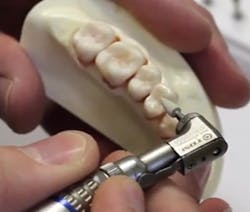Message in a Bottle Mailbag: Ultrasonic alternatives, amalgam polishing and mercury, March Madness and patient retention
The "Message in a Bottle Mailbag" is a monthly feature of the e-newsletter, Pearls for Your Practice: The Product Navigator. Each month, Editorial Director Joshua Austin, DDS, FAGD, answers reader-submitted questions to help you navigate your dental and hygiene product decisions (and more!). This month, he debates the alternatives to using an ultrasonic, gives his take on repolishing restorations, and shares the March Madness contest that he uses for patient retention.
______________________________________________________
ANSWER:
Man, that is a tough one. Nursing home dentistry has to be one of the toughest, most overlooked kinds of dentistry there is. Even just planning treatment for some of those patients is probably tough—let alone actually performing dentistry in that setting. Kudos to you for providing care to folks who probably wouldn’t get it otherwise!
As far as your question goes, there probably isn’t a great solution yet. The problem with using an ultrasonic without water is that the tips will get very hot and cause injury. If you are going to use an ultrasonic, you have to have irrigation and suction. Most hospital rooms have suction already, but it’s likely that they aren’t going to have a water line that you could plug into a regular ultrasonic. You would need a self-contained ultrasonic with its own water source. Many companies that make ultrasonics have a version with an attached water tank that would work in your setting. Unfortunately, however, we have yet to discover a technology that allows for power scaling without noise and water. Maybe one day. Until then, you will have to stick to self-contained ultrasonics and hand instrumentation. Keep fighting the fight, Dr. Hales!
______________________________________________________
QUESTION:ANSWER:
Thanks for writing in, Lori. You are right. Polishing of restorations is a valuable service to patients. Direct restorative materials tend to lose their luster over time, and repolishing can really extend their longevity—especially with anterior resin composites. You are right: Amalgam does release very small doses of mercury when polished. But if you do it in a moist environment with high-volume suction, the release is almost insignificant. Polished restorations inhibit biofilm formation, which is beneficial for plaque reduction, making it a great service to provide to your patients.
I would recommend that hygienists check with their states’ Dental Practice Acts and their delegating dentists to ensure that repolishing is permissible by state law and by the standard of care within your practice. As long as the dentist is cool with you polishing existing restorations, check into the polishing products your practice has. While I would probably leave the porcelain polishing to the dentist, resin polishing can be done fairly easily using the polishing adjuncts that are already in the practice. Existing amalgam polishes well with simple brownie and greenie points at low speeds with water spray.
______________________________________________________
QUESTION:ANSWER:
Of course you love the National Collegiate Athletic Association (NCAA) Tournament in Kentucky. It’s been crazy how good Kentucky has been this year and over the past decade. John Calipari has this thing down to a well-oiled machine; the crazy thing is that all of his players leave after a year, and he just keeps reloading. Kentucky made a strong run to the Final Four before the upset by Wisconsin. It’s hard to remember a year like this since the dawn of everyone filling out a bracket—although UCLA certainly had a run like that with Wooden, before the bracket fad hit. Undefeated until the Final Four, it seemed like beating Kentucky would be a monumental task.
I actually use the NCAA Tournament as a patient retention tool. For the past six years, I have had a bracket challenge for my patients. Basically, I set up a private bracket challenge group on Yahoo and push out the invite over email and social media channels. I offer the winner a prize, which is usually an Apple product of some sort. This year, the grand prize is an Apple iPad Air 2, and we’ve had over 100 entries. My patients love it—they start asking about it in February!
So that leads me to my point: If there is some event that you really enjoy, try to make it a communal experience for your patients. If you love the rodeo that comes every year, have a contest to give away tickets. If you really enjoy a yearly festival that happens in your town, set up a table or booth where you give out toothbrushes with your name on them. Whatever it is that you enjoy, make your patients a part of it. They always appreciate contests and giveaways, but what they really enjoy is getting to know what you like and learning more about your life outside of dentistry.
______________________________________________________
Editor's Note:Do you have a question for Dr. Austin? Is there a product you'd like to see him review? Or would you like to submit your own "Pearl"? Tweet to @pearlmail or send an email to [email protected]. You might just see it in the e-newsletter, Pearls for Your Practice: The Product Navigator! If you're not a Product Navigator subscriber, click here to sign up.
MORE MAILBAGS
March 2015 | Livionex dental gel, obturation with EdgeEndo, hockey, and the 2015 Oscars
February 2015 | Avoiding complaints, treating lip biters, a baseball glossary, and the Super Bowl
January 2015 | The Navigator name, 3M ESPE's True Def, and college football playoffs




